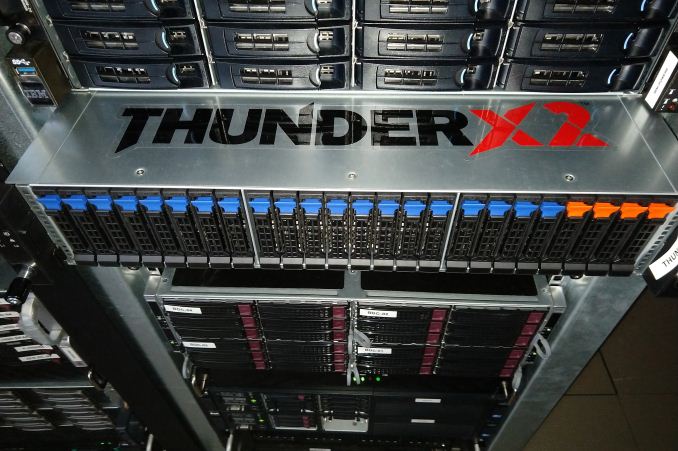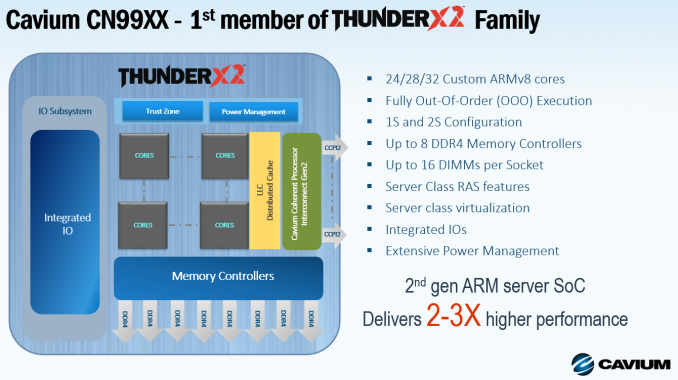Assessing Cavium's ThunderX2: The Arm Server Dream Realized At Last
by Johan De Gelas on May 23, 2018 9:00 AM EST- Posted in
- CPUs
- Arm
- Enterprise
- SoCs
- Enterprise CPUs
- ARMv8
- Cavium
- ThunderX
- ThunderX2

A little less than 2 years ago, we investigated the first Arm server SoC that had a chance to compete with midrange Xeon E5s: the Cavium ThunderX. The SoC showed promise, however the low single-threaded performance and some power management issues relegated the 48-core SoC to more niche markets such as CDN and Web caching. In the end, Cavium's first server SoC was not a real threat to Intel's Xeon.
But Cavium did not give up, and rightfully so: the server market is more attractive than ever. Intel's datacenter group is good for about 20 Billion USD (!) in revenue per year. And even better, profit margins are in 50% range. When you want to profits and cash flow, the server market far outpaces any other hardware market. So following the launch of the ThunderX, Cavium promised to bring out a second iteration: better power management, better single thread performance and even more cores (54).
The trick, of course, is actually getting to a point where you can take on the well-oiled machine that is Intel. Arm, Calxeda, Broadcom, AppliedMicro and many others have made many bold promises over the past 5 years that have never materialized, so there is a great deal of skepticism – and rightfully so – towards new Arm Server SoCs.
However, the new creation of underdog Cavium deserves the benefit of the doubt. Much has changed – much more than the name alone lets on – as Cavium has bought the "Vulcan" design from Avago. Vulcan is a rather ambitious CPU design which was originally designed by the Arm server SoC team of Broadcom, and as a result has a much different heritage than the original ThunderX. At the same time however, based on its experience from the ThunderX, Cavium was able to take what they've learned thus far and have introduced some microarchitectural improvements to the Vulcan design to improve its performance and power.
As a result, ThunderX2 is a much more "brainiac" core than the previous generation. While the ThunderX core had a very short pipeline and could hardly sustain 2 instructions per clock, the Vulcan core was designed to fetch 8 and execute up to 4 instructions per clock. It gets better: 4 simultaneous threads can be active (SMT4), ensuring that the wide back-end is busy most of the time. 32 of those cores at clockspeeds up to 2.5 GHz find a home in the new ThunderX2 SoC.
With up to 128 threads running and no less than eight DDR4 controllers, this CPU should be able to perform well in all server situations. In other words, while the ThunderX (1) was relegated to niche roles, the ThunderX2 is the first Arm server CPU that has a chance to break the server market open.











97 Comments
View All Comments
Wilco1 - Wednesday, May 23, 2018 - link
That's your uninformed opinion... Microsoft has different plans.ZolaIII - Thursday, May 24, 2018 - link
Windows is DOA anyway. M$ makes more money this day's on Linux then it does on Window's combined. Only thing making it still alive is MS Office but even that will change in couple of years.Wilco1 - Thursday, May 24, 2018 - link
Calling Windows dead when it ships on 95+% of PCs sold is eh... a little bit premature. Get back to me when 50+% of PCs ship with Linux instead of Windows.ZolaIII - Friday, May 25, 2018 - link
Get back to me when windows ships with 5% in; servers, embedded, router's, smartphones...jimbo2779 - Thursday, May 24, 2018 - link
In what way is it making more from Linux?ZolaIII - Friday, May 25, 2018 - link
https://www.computerworld.com/article/3271085/micr...Even your Windows PC, Office and everything else from Microsoft this day's is backed up by a cloud which is Linux based.
defaultluser - Wednesday, May 23, 2018 - link
Page 11 has "Apache Spark and Energy Consumption" in the title, but the page only containsApache Spark results. WHERE IS THE ENERGY CONSUMPTION?
We need power consumption tests during benchmarks to show if the architecture has better perf/watt than Intel. Otherwise, why did you publish this obviously incomplete article?
Ryan Smith - Wednesday, May 23, 2018 - link
Whoops. Sorry, that was a small section that was moved to page 5.ruthan - Wednesday, May 23, 2018 - link
Well, where is the most important chart performance per dollar comparison with x86 solution?That virtualization support, is some arm specific yes i we need feature and proprietary hell like Lpars.. or its finally support Vmware? - that means virtualization.
Where is could it run Crysis test?
HStewart - Wednesday, May 23, 2018 - link
VMWare is not currently support - and probably not for a long time - unless they ran in emulation mode and it would slower than Atomhttps://kb.vmware.com/s/article/1003882